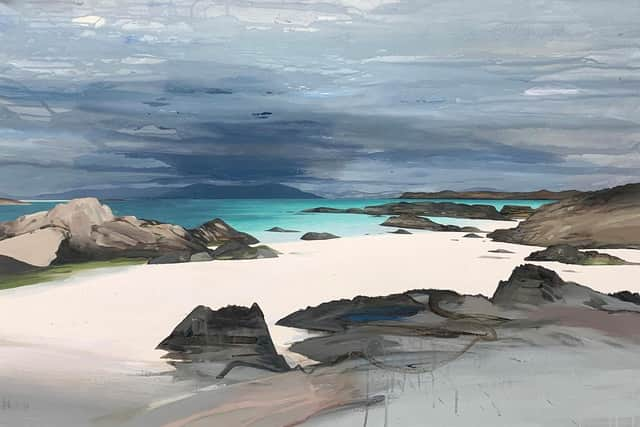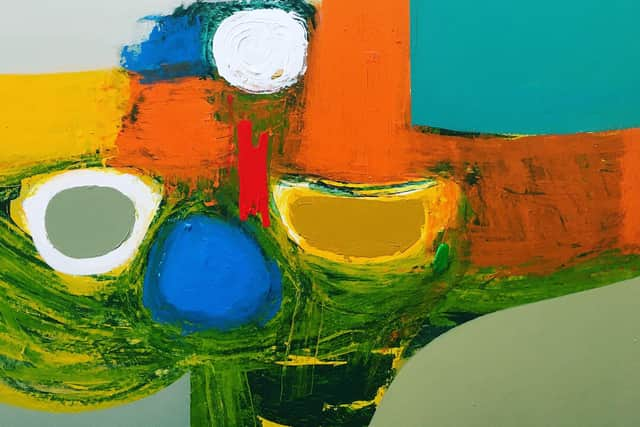Art reviews: RSW 142nd Annual Exhibition | William Littlejohn | Alison Dunlop | January in Edinburgh
RSW 142nd Annual Exhibition, Royal Scottish Academy, Edinburgh ****
William Littlejohn: In New Light, Royal Scottish Academy, Edinburgh ****
Advertisement
Hide AdAlison Dunlop: Between Heaven and Earth, Scottish Gallery, Edinburgh ****


January in Edinburgh, Fine Art Society, Edinburgh ****
Founded in 1877 the Royal Scottish Society of Painters in Watercolour, always known as the RSW, is nearing its 150th anniversary. The first president was Sam Bough, shortly succeeded by William McTaggart. The medium was widely regarded as inferior to oil paint and indeed was seen by some as really only a suitable accomplishment for refined young ladies and amateurs. A watercolour was also cheaper to buy than an oil painting. It is, however, a rich and complex medium – just look at the Turner watercolours still on show downstairs in the RSA – and so, when the RSW was founded, there was a struggle going on for its status. These first presidents were real heavyweights, especially McTaggart, and the plan was to put watercolour on the same footing as oil paint. In the near century and half that the society has flourished these old hierarchies have vanished. There are also new techniques and – as a water-based medium – acrylic now qualifies as watercolour for the RSW’s Annual Exhibition.
Still, given the society’s title, to adapt Marshall McLuhan, to an extent the medium is still the message and where the work in this year’s Annual Exhibitionstands apart is when it demonstrates the unique qualities that true watercolour has. In this spirit, in the current show Reinhard Behrens has paid homage to Arthur Melville, pupil of McTaggart, committed champion of the medium and one of the finest masters of it there has ever been. Behrens does quite well but I am not sure that anybody could ever quite match Melvilles’s luminous mastery, nor that he would have appreciated the intrusion of the artist’s signature submarines.
The current president of the Society is Angus McEwan and, suitably, his beautiful and atmospheric Waiting Room, a painting of an empty wooden chair catching the light beneath a sunlit window – time suspended as though it is the room itself that is waiting – is a lovely example of what watercolour can do. Ian Kinnear’s Letting in the Light is coincidentally a rather similar image of a sunlit window, but with tall weeds casting their shadow in the sunlight. The house is derelict, but the mood is poetic and the poetry in both these works is in the beauty of the medium and the way it is handled. It is of course also very versatile. Ian Ritchie, for instance, combines it with a subtle use of collage to suggest time and memory in The Ornithologist, a very striking head of a woman in a plumed hat holding an opera glass.


Watercolour can be very precise without ever seeming heavy or overburdened which is why it is so well suited to painting flowers and plants. The thistles and tall grasses in Wayside Verge by Sheila Hardy are a very nice example of this. Anita Barley paints in a similar way in Rambler’s Collection, studies of feathers, shells and still-life objects, but adds a narrative dimension in a second painting titled Heroes, referring it seems to an abandoned cap with 1939-45 on its brim and a small cluster of oak leaves. Camilla Seddon paints autumn leaves, seeds, nuts and feathers with equal delicacy. The flowers in Jenny Matthews’ Summer Garden are at once precise and free, while in Darren Woodhead’s November Hawes and Winter Thrushes, the paint sweeps across a big sheet of paper with dramatic runs and splashes yet the result is perfectly coherent. Pascale Rentsch’s Gorse by the Sea is handled with a splashy freedom verging on the abstract expressionist.
The catalogue doesn’t specify the media used, but the unique quality of watercolour is above all its transparency and this is generally recognisable. Claire Harkess, for instance, exploits this quality beautifully in Winter Song, birds among bare branches against a sky that shifts from dark blue night to scarlet sunrise. Robin Paine’s painting of forsythia in bloom is equally beautiful. In After the Rain Moira Ferrier uses the transparency of her medium to create a real sense atmosphere. In Rocks and Reeds Ruth Thomas seems first to have run splashy, grey and blue washes across the paper then added the rocks and reeds more precisely to give focus. Much of this painting is white paper and here as elsewhere you can see the importance of the support. This is another distinctive characteristic of the medium. You barely notice the caves in an oil painting, but in watercolour the paper is an integral part of the image, whether it simply shines as light though the transparent paint, or as texture, colour or indeed where the rough edges of the sheet are clearly visible. In Marian Leven’s lovely Casting a Shadow, for instance, a painting that exploits both the liquidity of watercolour and its transparency, the edges the paper standing proud from the mount are part of the image. In Matera, a lovely semi-abstract painting reminiscent of Paul Klee, Aileen Paton’s paper is crumpled with ragged edges. Janet Melrose’s Ground Sheet is just an enormous tattered collage laid flat on the floor with a partner on the wall above. However, Susan Macintosh brings all the qualities of watercolour together. In three beautiful big paintings, vertical sheets of paper hanging unframed, she has allowed the paint to follow gravity and settle in brilliant veils of colour. One of them, Early Rain North Uist, is clearly a landscape, but in the other two the artist seems simply to rejoice in the medium.
Advertisement
Hide AdGouache is akin to watercolour, but is opaque. Ian MacIntyre’s charming, cubist Circus combines the two media to great effect. Acrylic too is essentially opaque but can be handled as a wash and so can mimic some of the qualities of watercolour. Painted in acrylic, Allan Black’s Winter Sun, for instance, a wide view over houses lit by a low sun, catches the quality of the light as watercolour might do. Morag Muir’s complex, brightly coloured You & Me is vivid, but in a way that is really more like oil paint. Altogether, however, with nearly 300 works there is a great deal to see and the show is beautifully hung.
Downstairs at the RSA, In New Light is a selection of work by the late William Littlejohn. Here too the majority is watercolour with a finish and scale that could have impressed the founders of the RSW, although the largely abstract compositions might have baffled them. In paintings like Sunset Harbour, or Fish and River, Littlejohn seems also to experiment with Japanese paper. It has a visible fibre and the sense of integration of image and paper can be very satisfying. Yet another example of the diverse possibilities of watercolour and the integral importance of the paper it is painted on.
Advertisement
Hide Ad

At the Scottish Gallery, Alison Dunlop – who also features in the RSW show – uses the qualities of watercolour to great effect in great, sweeping images composed of wide washes of blue and white that suggest sky and sea. Her iconography at times seems limited to an arc of sky and a plane of horizon, but in paintings like Inner Sound Skyfall and Minch Snowfall IV, she breaks with that formula to move a little closer to landscape.
At the Fine Art Society, in a group of small works on paper, the late John McLean, unmatched as a master of colour, variously combines the brilliance of acrylic with watercolour and oil pastel. These works are in a mixed show titled January in Edinburgh, which ranges from Alexander Nasmyth and Horatio McCulloch to Will Maclean, John Byrne and Ken Curry – a delightful miscellany.
RSW 142nd Annual Exhibition until 16 February; William Littlejohn until 12 February; Alison Dunlop until 28 January; January in Edinburgh until 18 February